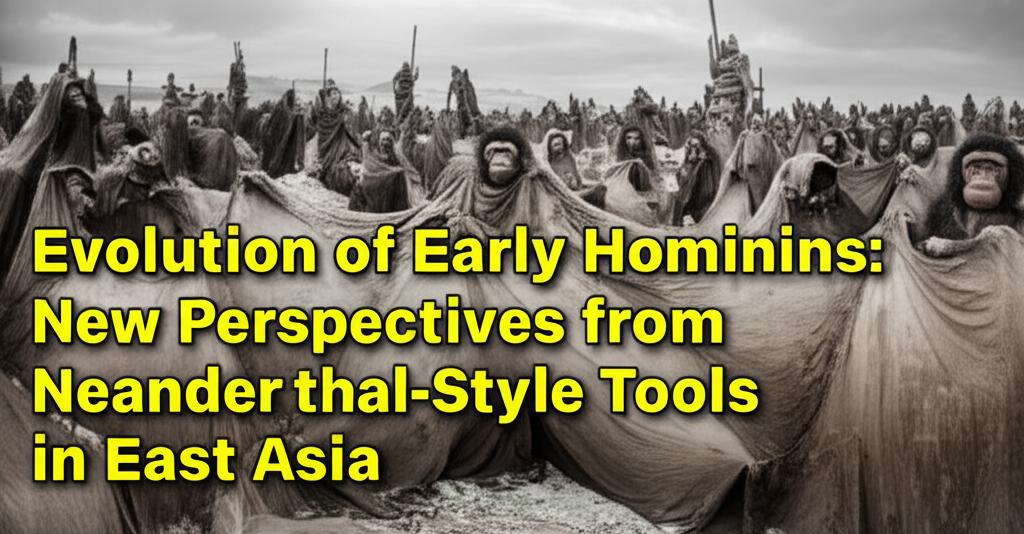The discovery of sophisticated "Neanderthal-style" tools in East Asia is prompting a significant re-evaluation of early hominin evolution, migration patterns, and technological capabilities in the region. Traditionally, the Middle Paleolithic period (roughly 300,000 to 40,000 years ago) in East Asia was viewed as technologically static compared to the dynamic developments seen in Europe and Africa, where cultures like the Mousterian, associated with Neanderthals, and the origins of modern humans were unfolding.
Challenging Old Paradigms with New Finds:Recent archaeological work, particularly at sites in China, is challenging this long-held perspective. A groundbreaking discovery at the Longtan archaeological site in Yunnan province, southwest China, has unearthed a complete Quina technological system. These stone tools, dated to approximately 50,000 to 60,000 years ago, are characteristic of a tool-making strategy often linked to Neanderthals in Western and Southern Europe during a similar period (Marine Isotopic Stage 4, about 57,000 to 71,000 years ago).
What are Quina Tools?Quina technology is a specific Mousterian industry. The Mousterian, in general, is defined by flake-based tools produced through various core-reduction techniques, typically including scrapers, denticulates (tools with notched edges), and retouched points. Quina tools, specifically, are known for their thick, robust scrapers made on large flakes, often featuring steep, scaled retouch (secondary shaping). These tools were well-suited for heavy-duty tasks. Wear-trace analysis on the Longtan Quina scrapers suggests they were used on a diverse range of materials, including bone, antler, wood, meat, hides, and non-woody plants, indicating their versatility.
Implications of the East Asian Discoveries:The presence of Quina technology so far east has several profound implications:
- Technological Sophistication: It demonstrates that hominins in East Asia possessed sophisticated tool-making capabilities, comparable to those in Western Eurasia, and were not limited to simpler core and flake technologies as previously thought. This forces a reconsideration of the idea that East Asia was technologically stagnant during the Middle Paleolithic.
- Hominin Dispersal and Interaction: The find raises questions about which hominin species made these tools. While Quina tools in Europe are strongly associated with Neanderthals, Neanderthal fossil remains have not yet been definitively identified in East Asia. This opens up several possibilities:
Neanderthals may have migrated further east than previously believed, bringing this technology with them.
Other archaic human groups, such as Denisovans (who are known to have inhabited Asia), may have independently developed or adopted this technology.
There might have been cultural transmission or exchange of ideas between different hominin populations across Eurasia.
The tools could belong to an as-yet-unknown hominin lineage.
- Adaptability: The development of such tools suggests hominins in East Asia were adapting to specific environmental conditions, possibly similar to the open forest-grassland environments and cooler, drier climates that Quina technology is associated with in Europe. Pollen analysis at the Longtan site indicates the inhabitants occupied an open forest-grassland mosaic environment.
- Rewriting Prehistory: These findings necessitate a revision of models concerning human migration patterns and the evolution of technology in East Asia. It suggests a more complex and dynamic picture of hominin presence and behavior in the region before the widespread arrival of early modern humans around 45,000 years ago.
The Longtan discovery is part of a growing body of evidence pointing to more diverse and advanced Middle Paleolithic technologies across China. Other notable finds include:
- Levallois Technology: Evidence of Levallois techniques (another sophisticated prepared-core tool-making method) has been found at sites like Guanyindong Cave in southwest China, dated to approximately 170,000-80,000 years ago. This was, at the time of its announcement, the earliest evidence of Levallois technology in East Asia. Other sites in Xinjiang and Inner Mongolia also show Levallois techniques around 50,000 years ago.
- Discoid Core Technology: The Xuchang hominin site in Central China has yielded evidence of discoidal core technology dating to around 125,000–90,000 years ago.
- Early Pleistocene Sophistication: Even earlier, at the Cenjiawan site in the Nihewan basin, prepared core technology dated to 1.1 million years ago suggests advanced technical abilities among Early Pleistocene hominins in East Asia, challenging notions of technological stasis even in that more ancient period.
The discovery of Neanderthal-style tools in East Asia opens exciting new avenues for research. Future work will likely focus on:
- Further Excavations: More archaeological investigations are needed to uncover additional sites and potentially more hominin fossils that could be directly associated with these tool industries.
- Dating and Analysis: Continued refinement of dating techniques and detailed analysis of lithic assemblages and associated environmental data will be crucial.
- Genetic Studies: If hominin remains are found, ancient DNA analysis could provide definitive answers about the species responsible for these tools and their relationships with other hominin groups.
In conclusion, the unearthing of Quina tools and other sophisticated lithic technologies in East Asia is transforming our understanding of early hominin evolution. It highlights the ingenuity and adaptability of hominin populations across vast geographical areas and underscores the interconnectedness, or perhaps independent innovation, of technological advancements during the Middle Paleolithic. This new perspective paints a far more dynamic and complex picture of human prehistory in East Asia than previously conceived.

